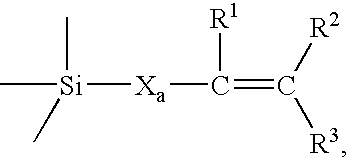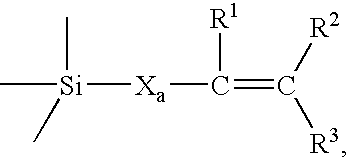Silicone binders for investment casting
- Summary
- Abstract
- Description
- Claims
- Application Information
AI Technical Summary
Benefits of technology
Problems solved by technology
Method used
Image
Examples
example 1
In this example, a 38% by volume ceramic article was cast using a mixture of 1,3,5,7-tetravinyl-1,3,5,7-tetramethylcyclotetrasiloxane and a poly[(methylhydrogen)-co-(dimethyl)]siloxane. In this case, the vinyl to silicone hydride molar ratio was maintained at 1:1. The ceramic was a mixture of amorphous silica and zircon. A 422 gram batch was prepared by mixing the various constituents for 15 seconds in a high-shear mixer operating at 2,500 rpm. Following mixing, the batch was degassed using a rotary vacuum mixer for 5 minutes operating at roughly 50 torr and 60 rpm.
The batch was then cast into a mock investment casting core by infiltrating a specially-designed steel die with the slurry at roughly 10 psi pressure. Following casting, the part was cured at 100° C. for roughly 30 minutes prior to part ejection. Following ejection, the part was cooled to room temperature.
Following casting, the part was fired in air at a rate of 10° C. per hour to a temperature of about 600° C., with...
example 2
Ceramic test bars were cast using a mixture of 1,3,5,7-tetravinyl-1,3,5,7-tetramethylcyclotetrasiloxane and 1,3,5,7-tetramethylcyclotetrasiloxane in a molar ratio of 1:1. The ceramic was a mixture of amorphous silica and zircon, present at 40% by volume. A 177.8 gram batch was prepared by mixing the constituents for 10 seconds in a high-shear mixer at 2,500 rpm. Following mixing, the batch was degassed in a rotary vacuum mixer for 5 minutes at roughly 50 torr and 60 rpm.
The batch was then loaded into disposable transfer syringes, and hand injected into a custom designed steel casting die. Approximate die opening dimensions were 0.1″×0.5″×5″. Following casting, the articles were cured at 50° C. for roughly 90 minutes prior to removal. The resultant article had a smooth hard surface, was strong and resilient, and could be readily handled without breaking.
example 3
Ceramic test bars were cast using a mixture of 1,3,5,7-tetravinyl-1,3,5,7-tetramethylcyclotetrasiloxane and a hydride functional silicate resin corresponding to Formula (VII), containing hydridodimethylsiloxy and silicate units in a molar ratio of 2:1. The total silicon hydride to vinyl molar ratio was 1:1. The ceramic was a mixture of amorphous silica and zircon, present at 40% by volume. A 177.8 gram batch was prepared by mixing the constituents for 10 seconds in a high-shear mixer at 2,500 rpm. Following mixing, the batch was degassed in a rotary vacuum mixer for 5 minutes at roughly 50 torr and 60 rpm.
The batch was then loaded into disposable transfer syringes, and hand injected into a custom designed steel casting die. Approximate die opening dimensions were 0.1″×0.5″×5″. Following casting, the articles were cured at 50° C. for roughly 90 minutes prior to removal. The resultant article had a smooth hard surface, was strong and resilient, and could be readily handled without ...
PUM
| Property | Measurement | Unit |
|---|---|---|
| Kinematic viscosity | aaaaa | aaaaa |
| Kinematic viscosity | aaaaa | aaaaa |
| Temperature | aaaaa | aaaaa |
Abstract
Description
Claims
Application Information
 Login to View More
Login to View More - R&D
- Intellectual Property
- Life Sciences
- Materials
- Tech Scout
- Unparalleled Data Quality
- Higher Quality Content
- 60% Fewer Hallucinations
Browse by: Latest US Patents, China's latest patents, Technical Efficacy Thesaurus, Application Domain, Technology Topic, Popular Technical Reports.
© 2025 PatSnap. All rights reserved.Legal|Privacy policy|Modern Slavery Act Transparency Statement|Sitemap|About US| Contact US: help@patsnap.com



